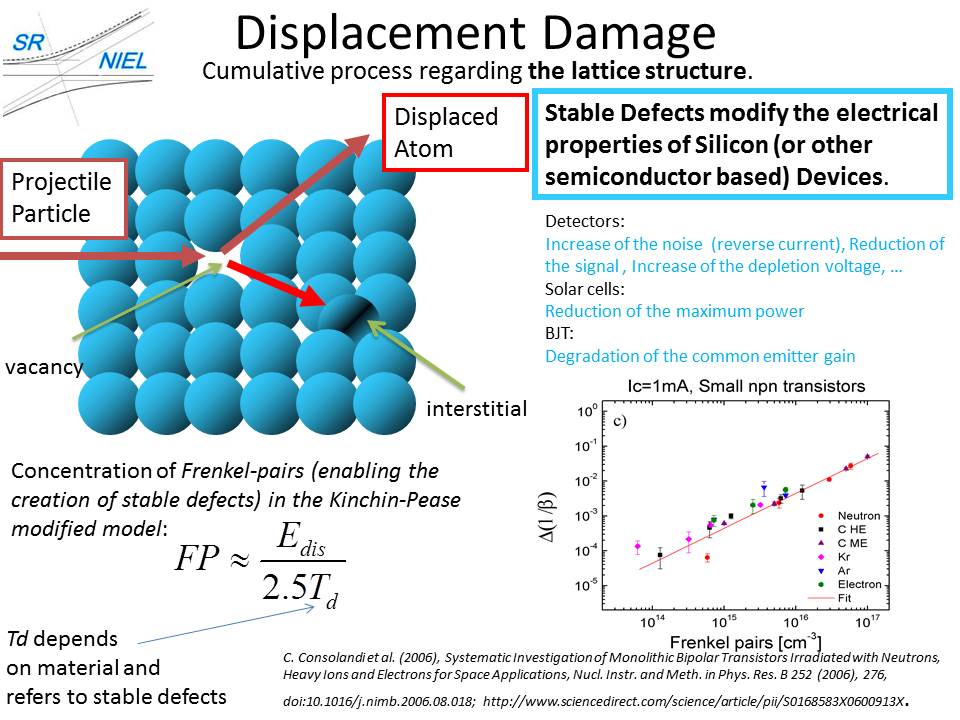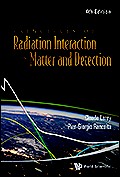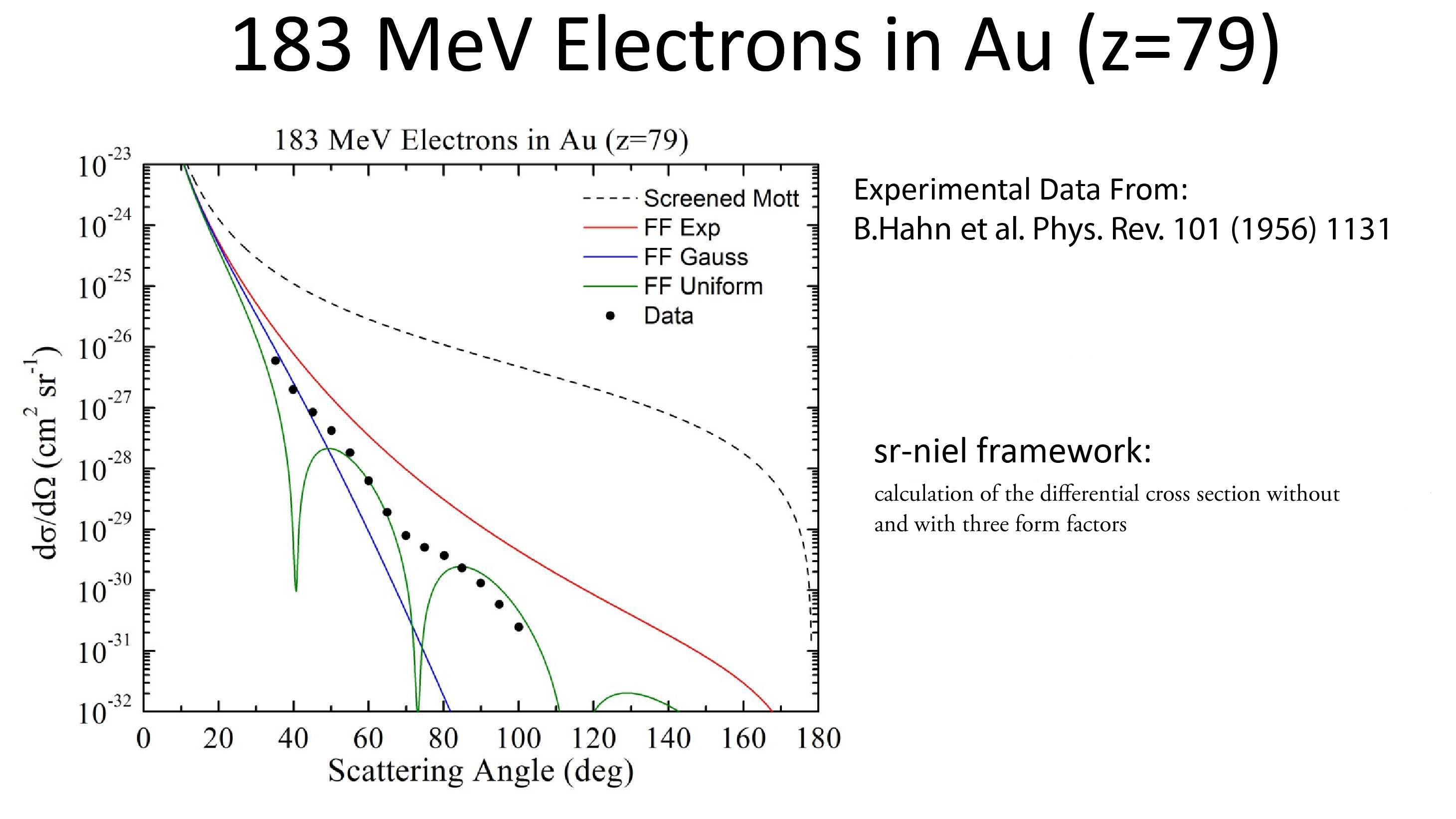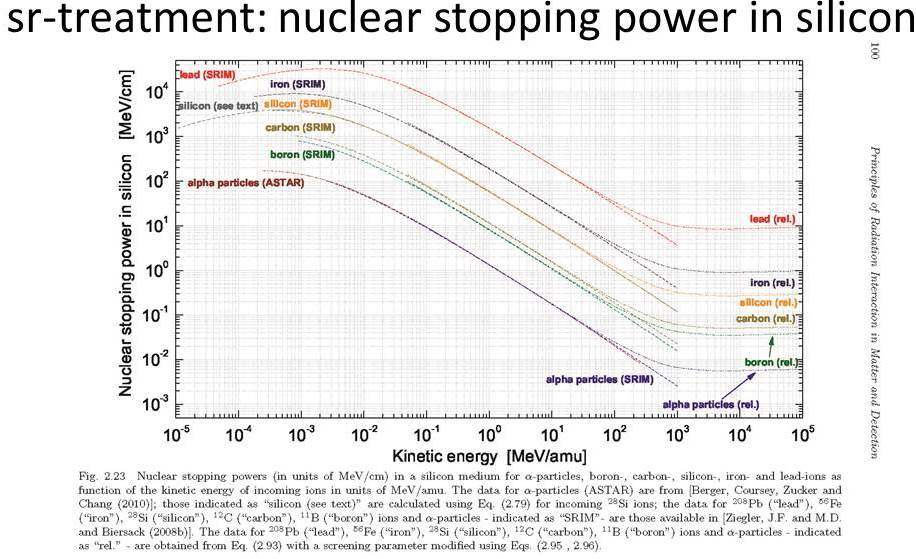Handbook of SR-NIEL–7 and nuclear stopping power (and TNID doses) calculators for elements and compounds (for instance, semiconductors); SR-framework for electronic stopping powers, restricted energy-losses and TID doses; large energy deposition effects in devices – e.g., single event effects (SEE) –; solar modulation models - including HelMod-4 - for cosmic rays and their impact on TID doses and SEEs; ASIF related irradiation facilities and space radiation environment topics
Welcome to the relativistic screening (SR) treatment handbook section of website. In these pages you can find information about physics process regarding the Screened Relativistic (SR) Calculators of the Non-Ionizing Energy Loss (NIEL) of electrons, protons, ions and neutrons passing through a material and generating displacement damages which, in turn, may introduce deep levels resulting from the Frenkel pairs created. In semiconductors, these stable defects can finally degrade the device performance (for instance, they can affect the current gain of bipolar transistors). Further information on radiation damage assessment for space missions is available at ASIF website.
Moreover, calculators for the nuclear stopping powers and NIEL doses – e.g., TNIDs also termed displacement damage doses – of electrons, protons, light- and heavy-ions and for the probability of generating energetic recoil nuclei are available. These calculations are carried out based on the screened relativistic treatment for (elastic) Coulomb interactions on nuclei from low up to ultra-relativistic energies.
The notation of screened relativistic (SR) NIEL was introduced by Baur et al. (2014). Furthermore, the treatment is discussed in Sects. Sects. 2.2.1–2.2.2, 2.4.2–2.4.3, 7.1.1.6, 7.1.1.8, 11.3.1, 11.3.2 of Leroy and Rancoita (2016) (see also Sect. 2 of Baur et al. (2014)). It regards the derivation of nuclear stopping power and NIEL dose for massive particles (e.g., see Sects. 2.2.1–2.2.2, 7.1.1.6 of Leroy and Rancoita (2016)) and electrons (e.g., see Sects. 2.4.2–2.4.3, 7.1.1.8 of Leroy and Rancoita (2016)) up to relativistic energies.
In sr-niel website, there are calculators available also for i) estimates of recoil energy fractions deposited via ionizing and non-ionizing process - using two of the mostly employed analytical approximations of energy partition function -, ii) electronic stopping powers from low up to high energies, restricted energy losses and ionizing doses (TIDs), and iii) SEEs (single event effect) treatment regarding the device cross section and expected number due to particle fluence. From version 6.3.0, web-calculators on electronic stopping powers – regarding the energy lost by particles traversing a medium – are complemented by those on restricted energy-losses to deal with both the energy deposited by incoming particles in absorbers and the approach to Fermi plateau at high energies.
Treatments involve particle interactions on elements and compounds (see section Physical constants and list of compounds).
From version 6.5.0, the occurrence probability of events due to a large energy deposition in devices - e.g., single event effects (SEE) - is additionally treated when it is induced by the electronic stopping power of incoming particles up to very hig energy; while from version 6.6.0 galactic cosmic rays fluxes are available from HelMod-4 model for being employed in sr-niel SEE calculator. From version 7.0.0, the SEE treatment is extended to deal with large energy depositions induced by Coulomb interactions on the nuclei of the absorber/target/device.
The treatment for the extension up to high energies of electronic stopping power and restricted energy loss for elements and compounds is referred to as SR-framework electronic stopping power and it is dealt in the section on Electronic stopping power up to high energy, restricted energy loss and Fermi plateau.
Within the so-called SR-(NIEL) framework, users can additionally access to calculators which allow one to obtains NIEL values and NIEL doses for neutrons in Si and GaAs absorbers, derived from ASTM-722-09, ASTM-722-14 and ASTM-722-19 standards.
Registered users can access to sr-niel web calculators i) in which it is implemented the Akkerman and Barak (2006) partition function and ii) to get NIEL doses for neutrons and neutron spectral fluence in some elements (C, N, Si, Ga, As, from version 3.5.1 0, Al, P, In, Cd, Te, Ge, Zn, Se, Sb, from version 3.9 Cu, Hg, Pb, S, Sn, from version 3.9.2 B, Bi, Cl, Tl, from version 4.5.0 Li, Ti, Mn, Br, Sr, Nb, Mo, Ag, I, Ba, La, Eu, U and from version 4.6.0 also H, He, Be, F, Na, Mg, Ar, K, Ca, V, Cr, Fe, Co, Ni) and their compounds, using Robinson and Akkerman partition functions. Additional nuclei available after version 4.6.0 are listed at this page. From version 8.5, NIEL dose calculation for neutron using Robinson and Akkerman partition functions are available obtained with NJOY-2021. A critical discussion on the usage of 1 MeV neutron equivalent is also available.
Together with geomagnetically trapped particles and galactic cosmic rays, solar protons (and other ions, electrons) can pose a hazard to both manned spaceflight and the sensitive components used in satellite subsystems and instrumentation. The physical mechanisms for radiation-induced damages have been investigated for many decades. They are related, for instance, to the type of particle and its energy, the device type, and its material composition (e.g., see this webpage). Further information on radiation damage assessment for space missions is available, as already mentioned, at ASIF website.
Topics regarding ASIF space radiation environment and related models on solar modulation (e.g., HelMod for cosmic rays transport in the heliosphere) and particle transport in Earth magnetosphere (GeoMagSphere) are currently available in section Space Radiation Environment and Models: SR-NIEL and ASIF, HelMod, GeoMagSphere related activities. The solar modulation impact on TID doses and SEEs are discussed in the section on Effects of solar modulation on particle flux per unit area as a function of particle energy or electronic stopping power/restricted energy loss per unit length, i.e., on TID and SEE.
From version 6.4.2, the topics covered in the present physics handbook are enlarged by referring to those treated in related activities discussed within ASIF (ASI Supported Irradiation Facilities), HelMod and GeoMagSphere websites.
The Bibliographies section includes two webpages. The former is dedicated to sr-niel publications on Displacement damage, SR-NIEL–7 treatment and methdologies, electronic and nuclear stopping powers; the latter regards those cited within calculators webpages.
This project is part of the activities involving also sr-niel / HelMod /geomagsphere / ASIF /AMS-02 Milano Bicocca group.
The implementation of derived sr-niel calculators into ESA (European Space Agency) codes (e.g., SPENVIS, GRAS and Mulassis) was accomplished under ESA contract 4000116146/16/NL/HK with title "Non-Ionizing Energy Loss (NIEL) Calculation and Verification".
For any comment, remark and suggestion, please contact us by email
Available SR-NIEL Physics treatments and related SR-Framework topics are listed grouped in sections:
- Screened relativistic (SR) Treatment and Displacement Stopping Power (NIEL)
- NIEL and Displacement Damage
- Energy Partition Functions
- Nuclear Stopping Power for Electrons, Protons and Ions
- Nuclear Recoil
- SR-NIEL and Solar Cells
- GaAs SR-NIEL tables
- SR-NIEL framework and displacement stopping power (NIEL) for Neutrons
- Nuclei for neutron damage functions
- SR-NIEL embedded in GRAS, Geant4, Mulassis, Spenvis
- Electronic stopping power up to high energy, restricted energy loss and Fermi plateau
- Effects of solar modulation on particle flux per unit area as a function of particle energy or electronic stopping power/restricted energy loss per unit length, i.e., on TID and SEE
- Kinetic Energy Thresholds for traversing an aluminum absorber
- Physical constants and list of compounds
- Space Radiation Environment and Models: SR-NIEL and ASIF, HelMod, GeoMagSphere related activities
- ASIF and irradiation facilites
- Bibliographies
Results and data comparisons about SR-NIEL treatment and SR-Framework electronic stopping power:
Screened Relativistic (SR) Treatment and Displacement Stopping Power (NIEL)
- Protons and Ions Scattering on Screened Coulomb Potential
- Rutherford Differential Cross Section at Relativistic Energies
- Electron Cross Section
- Summary of NIEL (Displacement Stopping Power) and NIEL Dose (TNID) in Elements and Compounds
- NIEL from Screened Coulomb Scattering of Protons and Ions
- NIEL from Electrons Scattering on Screened Nuclei
NIEL and Displacement Damage
- NIEL for Electrons and Protons in Silicon employing Robinson and Akkerman Partition Functions (registered users)
- Hadronic NIEL Contribution for Protons and alpha Particles (registered users)
- NIEL and Minority Carrier Lifetime
- Displacement Damage and Gain Degradation of BJT: the Generalized Messenger–Spratt Equation
Energy Partition Functions
- Summary of Energy Partition Functions
- Comparison of the Partition Functions of Akkerman and Robinson with Experimental Data
Nuclear Stopping Power for Electrons, Protons and Ions
- Summary on SR-Treatment on Nuclear Stopping Power for Electrons, Protons and Ions in Elements and Compounds
- Nuclear stopping power for protons and ions
- Electron Nuclear Stopping Power
- Nuclear stopping power for compounds in commonly employed non-relativistic treatments
Nuclear Recoil
SR-NIEL and Solar Cells
GaAs SR-NIEL tables
SR-NIEL framework and displacement stopping power (NIEL) for Neutrons
- Summary of Neutron Damage Function, NIEL and Hardness Parameter
- Neutron Spectral Fluence
- Hardness Parameter and 1MeV Neutron Equivalent
- Damage Functions and Doses from NJOY-2021 and NJOY-2016 when ENDF/B.VIII.0 Cross Section Library is employed
- Results for NIEL in Silicon Absorber from NJOY 2021 and ASTM-E722 versions
- NIEL Doses in Si and GaAs for Neutrons using Robinson and Akkerman Partition Functions
- Comparison of Damage Functions obtained with Akkerman and Robinson Partition Functions (registered users)
- Determination of the Damage Function at 1 MeV (registered users)
- Neutron Damage Function in Bi and Si (registered users)
Nuclei for neutron damage functions
SR-NIEL embedded in GRAS, Geant4, Mulassis, Spenvis
Electronic stopping power up to high energy, restricted energy loss and Fermi plateau
- Electronic Stopping Power, Restricted Energy Loss, Fermi Plateau and Linear Energy Transfer
- Massive Particles with z=1 in Silicon: Electronic Stopping Power, Restricted Energy Loss and Deposited Energy, experimental evidence of approaching the Fermi Plateau
- Restricted Energy-Loss Treatment within SR-Framework of Electronic Stopping Power for dealing with Particle Energy Deposition in a Medium
Effects of solar modulation on particle flux per unit area as a function of particle energy or electronic stopping power/restricted energy loss per unit length, i.e., on TID and SEE
- LET Distributions for Fe-Ions from SPENVIS, CREME and SR-NIEL/HelMod Frameworks: dependence of the estimated number of SEE on Solar Modulation Model
- Case Studies on TID and SEEs when Restricted Energy-Loss is employed with respect to the usage of Electronic Stopping Power
- Case Study on SEEs employing the Restricted Energy-Loss and dependence on Solar Modulation Model
- Impact of Solar Modulation on Particle Flux per unit area as a function of Particle Energy or Electronic Stopping Power or Restricted Energy-Loss
Kinetic Energy Thresholds for traversing an aluminum absorber
Physical constants and list of compounds
- Physical Constants and Atomic Weights in SR-NIEL Treatment
- List of Compounds for dealing with Non-Ionizing Energy Loss (NIEL) of Electrons, Protons, Ions and Neutron
- List of Compounds for dealing with Electronic Stopping Powers of Protons and Ions
- List of Compounds for dealing with Electronic and Radiative Stopping Powers of Electrons
Space Radiation Environment and Models: SR-NIEL and ASIF, HelMod, GeoMagSphere related activities
Space Radiation Environment and ASI related activities
- Space Radiation Environment within the Context of ASIF Activities and Radiation Damage Assessment for Space Missions
- Radiation environment: scientific and technolical activities, tool developments
HelMod-4: the solar modulation model of galactic cosmic rays employed within SR-NIEL framework
- HelMod-4, the Solar Modulation Model of Galactic Cosmic Rays employed within SR-NIEL Framework: comparison with AMS-02 Observation data and other commonly employed Modulation Models
- Impact of ultra-heavy GCR ions (e.g., with Z>28) on the overall expected SEE rate
- HelMod-4/CUDA and GPU-Farm
HelMod-4 : the solar modulation model for galactic cosmic rays transport
- Propagation of Galactic Cosmic Rays through the Heliosphere with HelMod-4: the Treatment of Solar Modulation
- Cosmic rays Propagation in Heliosphere and HelMod Model
- Local interstellar Spectra from Galprop-HelMod Join Effort
HelMod-4 Model: forecasting of cosmic rays fluxes through heliosphere and heliospheric boundaries
- HelMod Heliosphere
- Heliospheric Boundaries in HelMod: time dependent Termination shock and Heliopause
- HelMod Forecasting
- Predicting Galactic Cosmic Ray Intensities with HelMod-4 Model: Transfer Orbit Fluences at any Orbital Trajectory inside the Heliosphere
- HelMod-4 Model based web calculator for the Cosmic Rays Fluence along a Transfer Orbit in Deep Space Missions
Magnetosphere transport models
ASIF and irradiation facilites
- Asi Supported Irradiation Facilities (ASIF)
- ASIF Irradiation Facilities and Laboratories
- Methodologies and Characterization of ASIF Facilities
- NIEL Doses and Triple Solar Junctions: results with Electrons, Protons and Neutrons
Bibliographies
- Displacement Damage, SR-NIEL–7 Treatment and Methdologies, Electronic and Nuclear Stopping Powers
- Cited Publications within SR-NIEL Calculators Webpages
- HelMod Bibliography
- Geomagsphere Bibliography
- ASIF Documentation


A comprehenseve treatment of the screened relativistic physical processes is found in: C. Leroy and P.G. Rancoita (2016), Principles of Radiation Interaction in Matter and Detection - 4th Edition -, World Scientific. Singapore, ISBN-978-981-4603-18-8 (printed); ISBN.978-981-4603-19-5 (ebook); https://www.worldscientific.com/worldscibooks/10.1142/9167#t=aboutBook; it is also partially accessible via google books.

